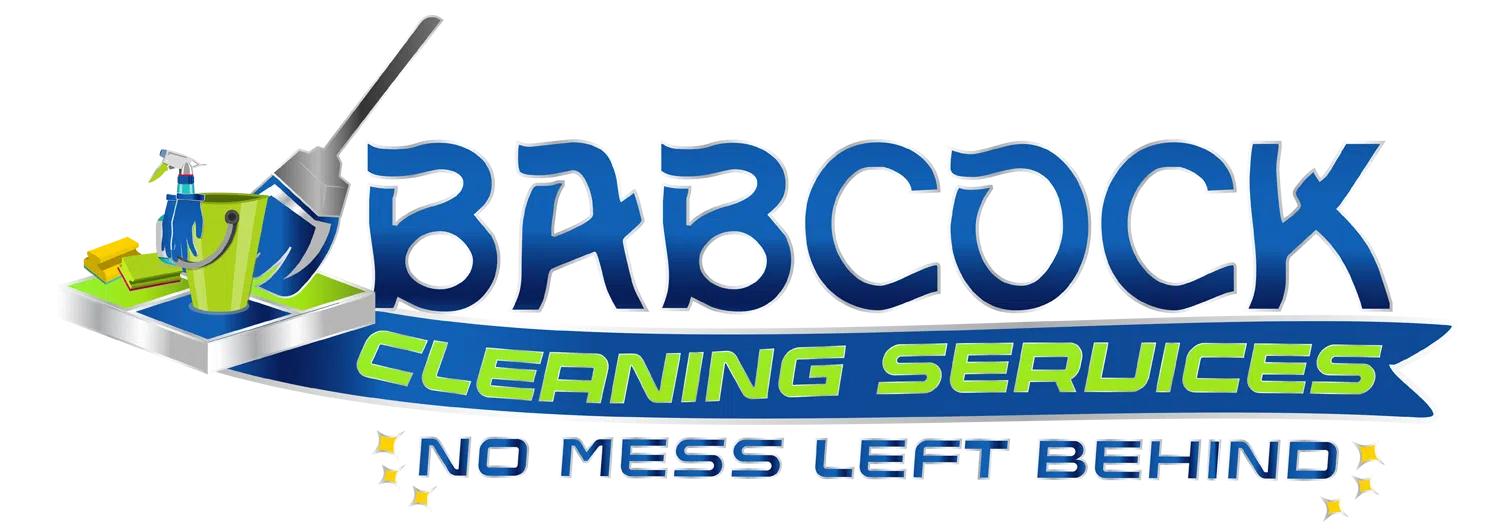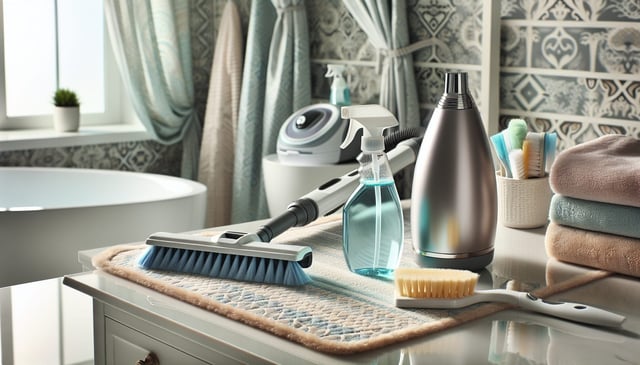Looking for a foolproof way to deep clean your bathroom? Our straightforward guide on deep cleaning bathroom demystifies the task, showing you exactly how to eradicate dirt, grime, and bacteria from every surface. Expect actionable advice for tackling stubborn soap scum, limescale, and more without fluff or fuss. Dive into our expert tips, and let’s make your bathroom sparkle together.
Key Takeaways
- Prep is crucial: Get your cleaning supplies in check, clear out personal items, and make sure the bathroom is well-ventilated before you start scrubbing.
- Target the tough stuff: Use a mix of white vinegar and water to tackle soap scum, while faucets and shower heads can be descaled with the same solution or a baggie soak.
- Don’t ignore the basics: Regularly clean high-touch surfaces like doorknobs and faucet handles, and use professional tips for stubborn issues like mold and hard-to-reach areas.
Preparation for Your Bathroom Deep Clean

For a successful deep cleaning, it is critical to prepare thoroughly. Doing so ensures that the entire cleaning operation runs smoothly and no area is forgotten. To achieve an effective and streamlined clean, collecting all required supplies beforehand is essential. These fundamental supplies should include:
- scrub brushes
- microfiber cloths
- baking soda
- white vinegar
- toilet cleaner
- glass cleaner
- disinfecting spray
Employing an electric scrub brush can greatly improve the efficiency of your efforts by reducing the physical effort needed during the process.
With our arsenal of cleaning products at hand, we are ready to move forward: preparing our space for deep cleaning while making sure there’s sufficient airflow throughout this endeavor.
Setting the Stage for Deep Cleaning
Prior to commencing our deep cleaning endeavor, it’s essential to prepare a clutter-free environment. This involves the temporary relocation of various personal and general items from the bathroom space. Such items include:
- toiletries
- bath toys
- grooming instruments
- shower curtains
- bath mats
Their removal is critical for an effective deep clean as it allows unimpeded access to all areas, facilitating a more thorough sanitation process.
Once we have decluttered the bathroom, our attention must turn towards another key preparatory measure—securing adequate ventilation within the space. Let’s address this important step immediately!
Ensuring Adequate Ventilation
Ensuring your bathroom has proper airflow is critical when embarking on a deep cleaning mission. Maintaining the right humidity levels by allowing air circulation helps to deter mold proliferation, which often results from the heightened moisture present during and after using showers and baths for a deep clean. Achieving this is straightforward: just crack open some windows or employ exhaust fans. Don’t forget that these fans need regular maintenance too. Dust them frequently and give their parts an in-depth cleanse periodically.
Now that our space is aptly prepared with adequate ventilation, it’s time to roll up our sleeves for the main event – eradicating soap scum and limescale deposits from our bathrooms. Let’s dive into the task at hand!
Attacking Soap Scum and Limescale

When you spot a filmy buildup on your shower doors or notice a powdery substance accumulating on your taps, these are the tell-tale signs of soap scum and limescale—infamous for stealing away the sparkle from your bathroom. Rest assured, there’s no need for concern as they can be readily removed with some know-how.
The creation of soap scum happens when soaps containing fatty acids meet calcium and magnesium ions present in hard water. This reaction forms a stubborn layer that ensnares everything from dirt to body oils and even bacteria within its grip. There is a silver lining: acidic substances such as white vinegar and lemon juice are excellent at dissolving these unwelcome deposits, thereby providing an efficient means to banish soap scum.
Armed with this insight into our adversarial residue buildup, let’s delve into effective tactics for eradicating stubborn soap scum off shower enclosures and curtains while also learning how best to rid faucets and showerheads of scaling.
Focus on Shower Doors and Curtains
Soap scum often accumulates on shower curtains and doors, making them challenging to keep clean. To tackle this issue:
- Prepare a solution with equal parts of water and white vinegar. Apply it to the walls and doors of your shower to dissolve soap scum—just give it some time before you start scrubbing.
- For an impeccable shine on glass shower doors, consider using a stronger product such as Rain-X X-Treme Clean Shower Door Cleaner.
- A squeegee is useful for wiping away excess water from your walls and doors. Follow up with cleaning spray or distilled white vinegar application, then wipe thoroughly for that spotless look.
Plastic shower curtains are prone to accumulating soap scumb build-up too. Don’t worry: spraying them with a mixture of vinegar and water followed by rinsing off the solution afterward will effectively remove any traces of residue from your curtain. With our curtains now sparkling like new again, let’s turn our attention toward getting faucets as well as the shower head back into tip-top condition!
Descaling Faucets and Shower Heads
Often neglected during regular bathroom clean-ups, faucets and showerheads can accumulate limescale, which hampers water flow and reduces pressure. This problem is easily remedied using a descaling solution composed of white vinegar and water in equal measure. To effectively remove the buildup, immerse your faucet and showerhead in the mixture or attach a plastic bag brimming with it over them for some time.
After allowing sufficient soaking time, reattach these fixtures and flush water through them to assess any improvements in their performance regarding flow and pressure. The result? Limescale-free faucets and shower heads that function optimally once again.
With those tasks completed successfully, let’s shift our focus to another crucial feature within the bathroom space – the toilet.
Toilet Transformation: From Bowl to Base

The toilet holds paramount importance as a key component in your bathroom and demands diligent cleaning from the bowl to its very foundation. Initiate by sanitizing the base of the toilet, applying either a disinfectant or hydrogen peroxide liberally, allowing it to dwell before scrubbing away any dirt. Should you encounter particularly tenacious stains on the bottom part of your toilet, employ an effervescent concoction made from baking soda and vinegar for effective results.
With the base now immaculately clean, shift focus towards tackling grime within the toilet bowl while ensuring that all external surfaces are sanitized thoroughly.
The Toilet Bowl Challenge
Cleaning the toilet bowl might seem tough with its enduring hard water rings or blemishes. Yet, it’s manageable when equipped with suitable tools and cleaning agents. Here’s your strategy:
Firstly, slather on some toilet cleaner and attack the inner surface of the toilet bowl with a scrub brush. Let this solution work its magic for no less than 15 minutes prior to flushing.
In cases where stains stubbornly cling on, harnessing a pumice stone may be key in eradicating mineral accumulations.
As an alternative approach, consider using hydrogen peroxide as a substitute for bleach to achieve both disinfection and a brightening effect.
Once you’ve achieved that sparkling interior finish within your toilet bowl, you can then turn attention towards purifying all external areas of the fixture itself.
Sanitizing Exterior Surfaces
It is essential to clean and sanitize surfaces in the bathroom that are frequently touched to maintain cleanliness and stop germs from spreading. Ensure you meticulously wipe down the exterior of the toilet, including parts like the flush handle, seat cover, lid, and underneath the rim, using a solution made with white. Vinegar or utilize a disinfectant spray for effective cleaning. Germ accumulation is common on faucet handles as well, so it’s wise to apply rubbing alcohol with a microfiber cloth for sanitization.
Once our toilet has been sanitized properly, we should focus next on other areas such as walls, windowsills, and flooring within our bathroom.
Floor to Ceiling: Walls, Windows, and Floors

Ensure every nook and cranny is attended to by thoroughly cleaning your bathroom from the top down. This means taking special care with your walls. You must select a suitable cleaning solution based on the paint type. For instance, use a gentle blend of warm water with non-abrasive cleaner or dish soap for latex-painted surfaces.
Paying attention to windows and floors is essential when performing deep cleaning tasks. Let’s explore. Into these areas, specifically focusing on wiping down walls and window sills, along with giving your bathroom floor an in-depth clean.
Wall and Window Sill Wipe Down
Over time, walls and window sills can gather dust and grime. To keep them clean, a mild solution of all-purpose cleaner or dish soap mixed with warm water is effective, particularly on surfaces coated with gloss or semi-gloss finishes. Wallpapered walls benefit from a delicate blend of warm water and dish soap applied with a soft sponge.
It’s important not to overlook the window sills. For an efficient cleaning that dissolves dirt without requiring vigorous scrubbing, employ a handheld steam cleaner. Having addressed the cleanliness of our walls and window sills, we shall now turn our attention to the bathroom floor.
Deep Clean Your Bathroom Floor
The floor in the bathroom often becomes a repository for all of the dirt and grime that is removed from other areas. It demands particular care. Start with vacuuming every part, including floors, corners, and countertops, to prepare a pristine surface before Cleaning.
When conducting deep cleaning of bathroom floors, utilize either one tablespoon of bleach mixed into a quart of water or choose an over-the-counter floor disinfectant for mopping purposes. For scrubbing the lines between tiles in your bathroom’s grout work effectively employ either hydrogen peroxide or create your own mix using baking soda combined with water.
With these steps taken to ensure cleanliness on your shower and overall bathroom flooring will be restored to looking as good as new—ready for you to apply those final enhancing touches that bring out their full luster and shine.
Final Touches: Details That Make a Difference

In the realm of deep cleaning, final enhancements are crucial as they significantly boost aesthetics and functionality. The key aspects include:
- Buffing light fixtures: A thorough cleansing helps illuminate the bathroom more effectively and fostans a hospitable ambiance.
- Ensuring that door knobs and faucet handles remain germ-free: Consistent sanitation of these touchpoints not only curtails microbial transmission but also maintains their pristine appearance.
Shifting focus to revitalizing light fixtures alongside preserving cleanliness in high-contact zones like door knobs and faucet handles elucidates. On these essential chores.
Refreshing Light Fixtures
The glow of bathroom light fixtures can be diminished by the buildup of dust and grime. To avoid this, a weekly regimen of dusting is advisable to reduce the need for more intensive cleanings. When dealing with clear glass light fixtures, it is suggested that they are cleaned monthly using a microfiber cloth. Polished metal can be maintained using only water or mild detergent soap, while painted fixtures should either be wiped with just a dry cloth or cleaned as necessary with plain water or gentle soap.
Having restored the radiance to your light fixtures, we now move on to ensure that door knobs and faucet handles are kept hygienic.
Door Knob and Faucet Handle Hygiene
Faucet handles and door knobs are touched often, making them hotspots for germs. To curb the transmission of these microbes, it’s important to consistently disinfect these surfaces using an appropriate solution. Outside of thorough deep cleaning routines, maintaining hygiene on such items can be achieved by regularly applying an anti-bacterial spray or wiping them down with distilled white vinegar.
Your bathroom should shine after implementing these practices. There may be instances where tough issues continue to linger despite your efforts. Here we will delve into expert advice for tackling those persistent problems in bathroom cleaning maintenance.
Professional Insights for Stubborn Challenges
Despite consistent deep cleaning efforts, certain stubborn obstacles can continue to pose challenges. Professional guidance is available to overcome these issues. This guidance covers proven strategies for effectively cleaning intricate fixtures such as:
- Shower heads
- Grout lines
- Glass shower doors
- Toilet bowls
These professional insights contribute significantly to improving the thoroughness of bathroom cleanings.
Diving into these expert tips will begin with addressing mold and mildew problems before proceeding to tackle areas that are typically difficult to access.
Mold and Mildew Mastery
The persistent issues of mold and mildew in bathrooms can be effectively tackled using various cleaning agents. For hard surfaces, bleach is suitable while borax serves well for wood and metal. A concoction of hydrogen peroxide combined with baking soda or just vinegar alone works wonders on nonporous areas. To cleanse tiles and grout from mold, a natural solution composed of warm water mixed with either borax or vinegar is quite effective.
To keep mold at bay after removal, it’s crucial to address the underlying humidity problem that contributes to its growth. Sealing grout biannually helps prevent moisture from seeping in again. If the situation involves drywall infiltration by mold or extensive coverage over large wall sections, enlisting professional remediation services is advised for thorough and safe elimination of the issue.
Accessing Hard to Reach Areas
Tackling the overlooked crevices in your bathroom doesn’t have to be a daunting task. Employ tools like detail brushes, an electric pressure washer, and a toilet brush for efficient cleaning. Utilize the precision of a detail brush to meticulously clean window sills post-steaming for enhanced results. Aim a light-duty electric pressure washer at challenging areas such as where hinges attach to the toilet seat, effectively eliminating accumulated grime and dirt without inflicting damage.
And there we conclude, armed with expert knowledge that empowers you to defeat even the most persistent obstacles encountered during your deep cleaning odyssey.
Summary
Embarking on a thorough deep cleaning of your bathroom can initially seem overwhelming, but with the proper techniques, efficient tools and agents, coupled with some diligent scrubbing, you can turn your bathroom into an immaculate sanctuary. We’ve guided you through every aspect of the process from initial preparations to applying the finishing touches. Alongside addressing persistent issues like soap scum, limescale and mold head-on. We have provided expert advice to help you overcome even the toughest stains.
Keep in mind that maintaining a pristine bathroom goes beyond mere aesthetics – it’s about fostering a sanitary and soothing environment where relaxation is paramount. So don’t hesitate to roll up those sleeves and start your deep cleaning quest. The sense of satisfaction from seeing your transformed space will no doubt be worth the effort!
Frequently Asked Questions
What is the importance of deep cleaning a bathroom?
Deep cleaning a bathroom is important because it tackles hard-to-reach areas and stubborn stains, making it a fresh and relaxing sanctuary.
How can I effectively remove soap scum?
Try using acidic solutions like white vinegar or lemon juice to break down and remove soap scum. They can really help!
How can I tackle stubborn challenges like mold and mildew?
For addressing the issue of mold and mildew, one can utilize various products for successful removal. Bleach is suitable for hard surfaces, while borax serves well on wood and metal. Alternatively, vinegar or a combination of hydrogen peroxide and baking soda are effective on nonporous surfaces. It’s critical to select an appropriate product corresponding to the surface type in question.
How can I maintain door knob and faucet handle hygiene?
Regular disinfection of door knobs and faucet handles is crucial for hygiene, using either an antibacterial spray or distilled white vinegar to inhibit germ proliferation. Such practices aid in maintaining cleanliness until the time comes for a thorough deep cleaning session.
How can I access hard-to-reach areas in my bathroom?
To efficiently cleanse those challenging, out-of-reach areas in your bathroom, consider employing the use of specific instruments such as intricate detail brushes and powerful electric pressure washers.
These devices are designed to simplify the cleaning process significantly!





